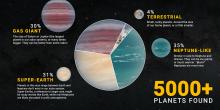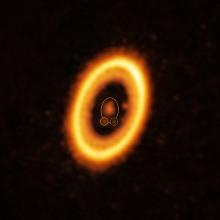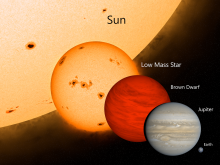Listen to today's episode of StarDate on the web the same day it airs in high-quality streaming audio without any extra ads or announcements. Choose a $8 one-month pass, or listen every day for a year for just $30.
You are here
Moon, Jupiter, Spica
The Moon slides between a couple of bright points of light tonight. The planet Jupiter is close to the lower left of the Moon as night falls. It’s brighter than anything else in the night sky except the Moon and Venus, so you can’t miss it. And the star Spica is a little farther to the right of the Moon.
Jupiter is the biggest, heaviest planet in the solar system. It’s about 11 times Earth’s diameter, and more than 300 times its mass. In fact, it’s heavier than all the other planets and moons in the solar system combined.
Yet Jupiter is insignificant compared to many planets found in other star systems. Some of those planets are up to a few dozen times heavier than Jupiter. And many of them orbit much closer to their parent stars than Jupiter is to the Sun.
But conditions close to a star are just too hot to allow the formation of big balls of gas like Jupiter and the giant exoplanets. So those other worlds probably formed much farther out, where conditions were much colder. Gravitational interactions with other planets then caused them to spiral closer in. That might have caused planets that were born even closer to fall into their suns.
Something similar could have happened in the solar system. Jupiter might have migrated inward, clearing out the close-in planets. It then moved out to its current position, allowing new planets to form closer to the Sun — including our own Earth.
More about Jupiter tomorrow.
Script by Damond Benningfield





